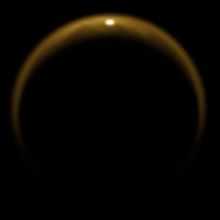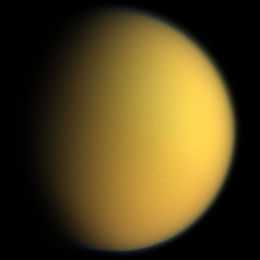Jingpo Lacus
|
Jingpo Lacus in a false-color synthetic aperture radar image of Titan's north polar region. An extension of Kraken Mare enters the view at upper left. | |
| Feature type | Lacus |
|---|---|
| Coordinates | 73°N 336°W / 73°N 336°WCoordinates: 73°N 336°W / 73°N 336°W |
| Diameter | 240 km[note 1] |
| Eponym | Jingpo Lake |
Jingpo Lacus is a lake in the north polar region of Titan,[1] the planet Saturn's largest moon. It and similarly sized Ontario Lacus[2] are the largest known bodies of liquid on Titan after the three maria (Kraken Mare, Ligeia Mare and Punga Mare).[3] It is composed of liquid hydrocarbons (mainly methane and ethane). It is west of Kraken Mare at 73° N, 336° W, roughly 240 km (150 mi) long,[1][note 1] similar to the length of Lake Onega on Earth. Its namesake is Jingpo Lake,[1] a scenic lake in China.
On 8 July 2009, Cassini's Visual and Infrared Mapping Spectrometer (VIMS) observed a specular reflection in 5 µm infrared light off Jingpo Lacus at 71° N, 337° W. (This has sometimes been described less accurately as at the southern shoreline of Kraken Mare.[4]) Specular reflections indicate a smooth mirror-like surface, so the observation corroborated the inference of the presence of a large liquid body drawn from radar imaging. The observation was made soon after the north polar region emerged from 15 years of winter darkness.[5]
Gallery
-

Synthetic aperture radar image (top) overlaid onto a visible light/infrared image of Titan's north polar region, showing Jingpo Lacus (at center) and other liquid bodies (Kraken Mare at bottom, Ligeia Mare at right and Punga Mare) outlined in blue.
-

Specular reflection off Jingpo Lacus, observed by the Cassini probe on July 8, 2009
Notes
- ↑ 1.0 1.1 The USGS web site gives the size as a "diameter", but it is actually the length in the longest dimension.
References
- ↑ 1.0 1.1 1.2 "Jingpo Lacus". Gazetteer of Planetary Nomenclature. USGS Astrogeology Science Center. Retrieved 2012-03-17.
- ↑ "Titan lacūs". Gazetteer of Planetary Nomenclature. USGS Astrogeology Science Center. Retrieved 2012-03-17.
- ↑ "Titan maria". Gazetteer of Planetary Nomenclature. USGS Astrogeology Science Center. Retrieved 2012-03-16.
- ↑ Cook, J.-R. C. (2009-12-17). "Glint of Sunlight Confirms Liquid in Northern Lake District of Titan". NASA web site Cassini mission page. NASA. Retrieved 2009-12-18.
- ↑ Lakdawalla, E. (17 December 2009). "Cassini VIMS sees the long-awaited glint off a Titan lake". The Planetary Society Blog. Planetary Society. Retrieved 2009-12-17.
External links
| ||||||||||||||||||||||||||||||||||||||||||

